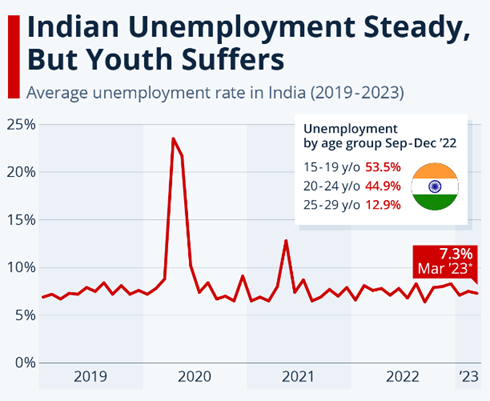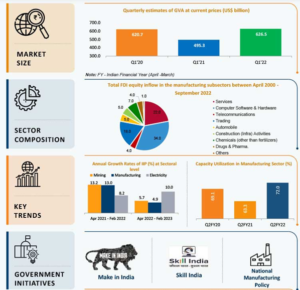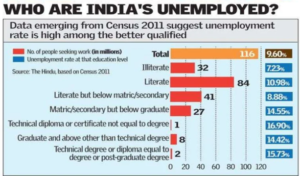Growth & the Tier 2 City.
Relevance
- GS 3: Urbanization, their problems and their remedies.
- Tags: #GS3 #Urbanisation #Jobcreation #Unemployment #IndianExpressEditorialAnalysis.
Why in the News?
As the Fastest-Growing large economy in the world, India’s high growth has attracted headlines. But, with nearly a quarter of youth unemployment cannot be overlooked. With over half the population below 25, the paradox of economic growth and joblessness requires attention.
India’s Economic Growth and Youth Unemployment: A Paradox
India stands out as the fastest-growing major economy globally, capturing international attention for its remarkable growth.
- Youth Unemployment Concerns: Despite impressive economic growth, a significant challenge is the nearly 25% youth unemployment rate, raising concerns.
- Youth Population Demographics: With over 50% of the population under 25 and 65% under 35, the young demographic is a dominant force.
- Contradiction: The coexistence of rapid economic growth and substantial youth unemployment creates a puzzling paradox.
India’s Youth: Growth, Unemployment, and Policy Impact
- Youthful Nation, Contrasting Realities: India’s simultaneous experience of high growth and unemployment isn’t a paradox but stems from imbalanced development policies.
- Policy Impact, Not Automation: The situation isn’t driven by automation or AI; rather, it’s a consequence of skewed policies that hinder job creation despite economic expansion.
- Unemployment Origins: Lopsided development policies have failed to generate sufficient employment opportunities for the millions entering the labor force annually.
- Youth as an Asset: India’s youthful demographic offers an advantage in a global context of aging populations, presenting opportunities for growth.
- Globalization’s Altered Path: Evolving trends in globalization have created new avenues for India’s growth, reshaping the economic landscape.
“Impact of Infrastructure Disparity on India’s Job Growth and Manufacturing Sector”
- Infrastructure Vital for Job Creation: India requires strong physical and human infrastructure for job generation.
- Imbalanced Progress: While physical infrastructure has seen significant improvement, human infrastructure like education and skills has lagged.
- Human Infrastructure’s Impact: Insufficient human infrastructure hampers job growth despite enhanced physical facilities.
- Urban Focus of Physical Investment: Physical infrastructure development tends to concentrate on urban areas.
- Manufacturing Shift to Rural Areas: Manufacturing relocates to rural zones for cost efficiency.
- Rural Challenges: Poor physical and human infrastructure in rural regions limits manufacturing growth due to constrained growth drivers.
India’s Education Challenges and Human Capital Potential
- Alarming Illiteracy Levels: India holds the world’s largest population of illiterate individuals. Over 1/3 of adults lack literacy and less than 20% complete secondary education.
- Unleashing Human Capital: While physical infrastructure growth has limitations, India’s potential to boost human capital through education is boundless.
- Education’s High Returns: Education investments outshine physical ones. Primary education offers around 20% social return, with higher education returns increasing significantly.
- World Bank’s Focus Shift: The World Bank’s historical emphasis on basic education has expanded to encompass higher education, recognizing its growing importance.
Enhancing Education Investment in India’s Rural Areas: Challenges and Solutions
| Challenges in Rural Education | Solutions and Strategies |
| Access, Quality, Relevance, Finance, Governance | Targeted Investment: Increase funding for rural education, addressing financial and infrastructure gaps. |
| Multidimensional Challenges | Quality Framework Implementation: Develop robust quality assurance systems for both public and private sectors. |
| Quality Variance Concerns | Faculty Empowerment: Enhance faculty compensation, flexibility in allocation, and professional development. |
| Absence of Quality Assurance | Curriculum Modernization: Update curriculum, adopt interactive teaching methods for critical skills. |
| Faculty Shortage and Disincentives | Industry Collaboration: Foster industry ties for curriculum alignment and practical exposure. |
| Curriculum and Pedagogy Obstacles | Innovation Promotion: Encourage innovative teaching approaches, student-centered learning. |
| Market Alignment Gap | Governance Overhaul: Revamp governance for effective oversight, accountability in educational institutions. |
Enhancing Education Governance and Scaling Tertiary Education
Complex Education System Governance: Challenges and Needs
- Growing Complexity: As education systems diversify, improved governance becomes essential for effective operation.
- Incentives and Accountability: Governance requires enhanced incentives, monitoring, performance evaluation, and accountability across internal processes and student outcomes.
Scaling Tertiary Education: Benefits and Challenges
- Tertiary Education Expansion: Increasing tertiary education access is crucial for boosting professional cadres, entrepreneurship, and job creation.
- Knowledge Dissemination: Tertiary education extends knowledge dissemination beyond universities, facilitating interactions between businesses and society.
Education Investments: Catalyst for Job Creation
- Job Acceleration – Policymakers should acknowledge that educational investments drive job growth.
- Enterprise Role – New enterprises are primary job creators, emphasizing the link between education and job opportunities.
- Skilled Workforce and Infrastructure – Both skilled labor and robust physical infrastructure are sought by domestic and foreign enterprises.
Leveraging India’s Youthful Demographic
- Youth Advantage: India’s substantial youth population holds immense potential to harness the benefits of education.
- Education’s Growing Significance: Education and skills play a crucial role as enterprises, foreign and domestic, consider local workforce quality for location choices.
India’s Infrastructure Investments and Manufacturing Sector
- India’s infrastructure investments are largely focused on urban areas.
- This has led to lopsided spatial development and slowed the pace of job creation.
- The manufacturing sector is rapidly de-urbanising and moving to rural areas.
- However, the manufacturing sector is not able to grow fast in rural areas due to lack of adequate physical and human infrastructure.
Lopsided Infrastructure Development and Manufacturing Shift
- 1990s Synchronization: India’s manufacturing sector grew in parallel with urbanization during the early 1990s.
- 2000s Reversal: Post-2000, manufacturing began de-urbanizing, moving away from urban areas.
- Rural Shift Factors: Manufacturers favor rural locations due to cost-efficient land prices, less stringent pollution rules, reduced congestion, and spatial considerations.
- Urbanization-Industrialization Divergence: India’s urbanization and industrialization trajectories have separated, leading to a disconnect.
- Premature De-industrialization: The manufacturing slowdown is termed as pre-mature de-industrialization, linked to the divergence between urbanization and industrialization paths.
Economic Growth Shift to Tier II Cities and New Urbanization Patterns
- Tier II Cities’ Role: Economic growth’s future lies in tier II cities, not tier I urban centers already saturated with talent.
- Job and GDP Potential: New cities could generate 70% of India’s jobs and GDP in the next 20 years, leading to per capita income rise.
- Global Trend: Intermediate cities, as seen in China and the USA, drive growth and job creation globally.
Urbanization-Industrialization Divergence: Policy Implications
- Policy Challenges: The disparity between urbanization and industrialization paths poses significant policy questions.
- Rural Development Scope: Rural development isn’t limited to agriculture; it should encompass manufacturing too.
Rural Structural Transformation and Infrastructure Scaling
- Comprehensive Rural Focus: Broader rural structural transformation is essential for robust job creation.
- Infrastructure Scaling: Policymakers should elevate investments in physical and human infrastructure, bridging the urban-rural gap.
Manufacturing De-urbanization’s Impact: Importance of Rural Agenda
- Rural Development Significance: Manufacturing’s shift to rural areas emphasizes the need for rural development and job creation focus.
The focus on tier II cities for growth, the gap between urbanization and industrialization, and manufacturing moving to rural areas highlight the need for thorough rural development and closing urban-rural gaps with better infrastructure investments.
Source: Indian Express
Mains Question
Explain the concept of “Manufacturing De-Urbanization” and its implications for India’s economic landscape. How can policymakers address this trend to ensure balanced regional development?






